New Hearing Loop System at Theatre NorthWest
Theatre NorthWest recently installed a hearing loop to replace our old FM hearing assist system. We were able to make this much-needed accessibility upgrade thanks to generous funding from the PG Community Foundation.
This document outlines how a hearing loop system works, what kind of hearing aids are compatible, and how to connect to the system at Theatre NorthWest. If you have questions about accessibility at the theatre, please contact Heidi Klepsch, the accessibility coordinator, at heidi@theatrenorthwest.com If you have questions about your hearing aids, please contact your audiologist.
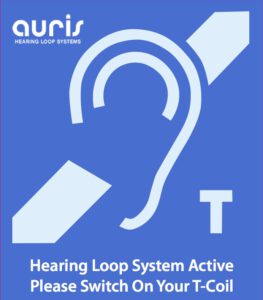 What is a hearing loop system?
What is a hearing loop system?
A hearing loop is a sound amplification system for people with telecoil-equipped hearing aids or cochlear implants. They are a form of accessibility technology commonly found in the UK. Hearing loops are slowly becoming more popular in Canada. These systems are usually installed in public places such as banks, government service centres, churches, theatres, teaching spaces, concourses, and museums.
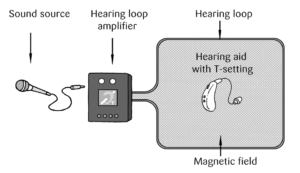 How does it work?
How does it work?
A hearing loop system involves a microphone, amplifier, induction loop cable, and a receiver. The receiver is a hearing aid or cochlear implant with a telecoil function. If someone does not have one of those devices, they can use a small, portable, specialized hearing loop receiver with headphones.
Sound is picked up by the microphone, made louder by the amplifier, then transmitted through the induction loop cable. Once someone is within the looped area, they can switch on their hearing telecoil function and immediately hear the amplified sound.
What are some of the benefits?
A hearing aid’s internal microphone cannot always separate the sounds someone wants to hear from those they don’t. This can be especially obvious in crowded settings where the sound source is far away. A hearing loop helps in these scenarios. Our hearing loop’s microphone is positioned directly over the stage, meaning the sound you want to hear is amplified, while noise from the audience and building is suppressed. Wherever someone is sitting in the audience, they will be able to hear clear sound from the stage when connected to the hearing loop system.
Hearing loops are discreet, simple, and effective. As long as someone has a telecoil-equipped hearing aid or cochlear implant, they don’t need any additional equipment to hear the amplified sound. They can simply take their seat, turn on the tele-coil function, and enjoy the show. Furthermore, since the audio signal is delivered directly into a recipient’s personal hearing device, the sound profile will be tailored to their unique needs. This is far superior to an FM or infrared hearing system, which delivers a one-size-fits-all sound profile.
What is a telecoil?
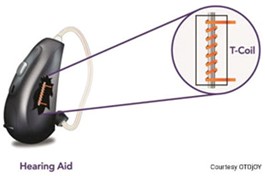 A telecoil (also called a T-coil) is the component within a hearing aid or cochlear implant that receives the audio signal from the hearing loop system. A hearing aid must have a telecoil to be compatible with a hearing loop system. The telecoil must be switched on while someone is within the looped area to receive the hearing loop signal.
A telecoil (also called a T-coil) is the component within a hearing aid or cochlear implant that receives the audio signal from the hearing loop system. A hearing aid must have a telecoil to be compatible with a hearing loop system. The telecoil must be switched on while someone is within the looped area to receive the hearing loop signal.
Do my hearing aids have a telecoil?
Most modern hearing aids (approximately 80%) and all modern cochlear implants have a T-coil. However, we strongly recommend contacting your audiologist prior to coming to the theatre and using the hearing loop for the first time. Your audiologist will be able to:
- Confirm that your hearing aids have a T-coil
- Activate the T-coil so that it’s functional
- Teach you how to properly use it
If your hearing aids’ telecoil feature has not been activated by your audiologist, it will not be able to connect to a hearing loop. Please see your audiologist to confirm that your hearing aids are compatible with a hearing loop system.
How do I use the telecoil function?
All hearing aids and cochlear implants are different. Depending on the model you have, you might switch to the T-coil setting by:
- Flipping a switch located on your hearing aids, or
- Changing a setting in the smartphone app associated with your hearing aids
Please see your audiologist to learn how to control your personal hearing device.
Do I need to be in a specific location to connect to the hearing loop?
Yes. You must be within a looped area to connect to the hearing loop system. There are two looped areas at Theatre NorthWest:
2. The front desk/box office counter
When will the hearing loop be turned on? When can I connect to it?
The hearing loop in the main/lower audience section will be on during performances. When you take your seat, you can connect by switching to the T-coil input setting. Switch back to your hearing aids’ regular input setting when you exit the auditorium.
The hearing loop at our front desk/box office will be on whenever the desk is in use. When you are standing in front of the desk, switch to the T-coil input setting. When you walk away from the front desk, switch back to your hearing aids’ regular input setting.
What if I don’t have a hearing aid with a telecoil or a cochlear implant?
You can still c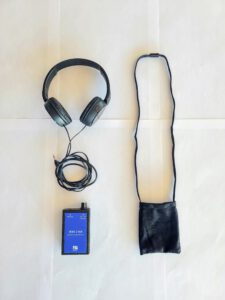 onnect to the hearing loop! Request one of our two portable receivers at the front desk/box office. Please note that receivers and headsets must be returned before leaving the theatre.
onnect to the hearing loop! Request one of our two portable receivers at the front desk/box office. Please note that receivers and headsets must be returned before leaving the theatre.
The portable receiver is a small black box with a volume control knob on the top. It delivers amplified sound through wired headphones. You can connect your personal wired headphones or earbuds to the receiver. Alternatively, you can borrow a headset from the theatre. Our headsets sit on top of the ears and are sanitized between uses.
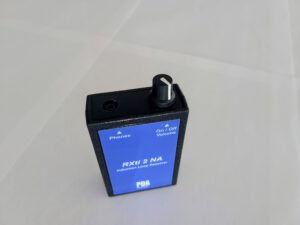 To turn the receiver on, rotate the volume knob. Please note that there will be a loud popping sound when it first turns on. To avoid hearing this, put on the headset after turning on the portable receiver. Rotate the knob to increase the volume as needed.
To turn the receiver on, rotate the volume knob. Please note that there will be a loud popping sound when it first turns on. To avoid hearing this, put on the headset after turning on the portable receiver. Rotate the knob to increase the volume as needed.
Please note: The sound quality from portable receivers is highly dependent on their orientation. The best sound quality happens when the receiver is held vertically, with the blue side facing the stage. To ensure proper positioning throughout a performance, we suggest wearing the receiver in the included pouch. Place the lanyard strap over your head so the receiver hangs in front of your torso.

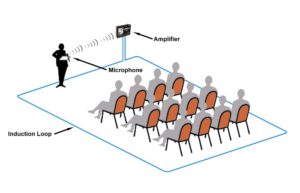


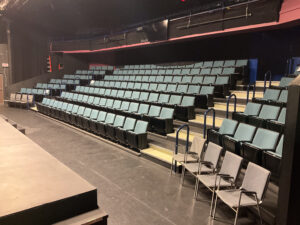
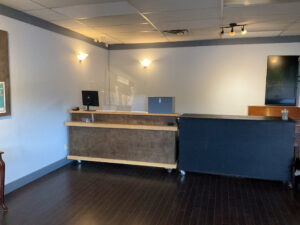
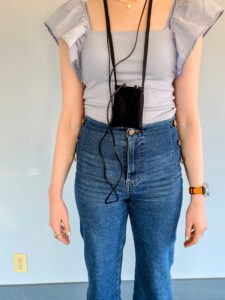
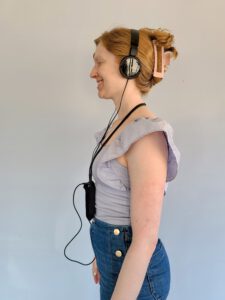

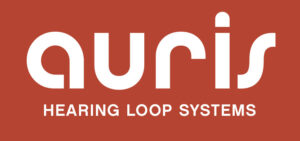
You must be logged in to post a comment.